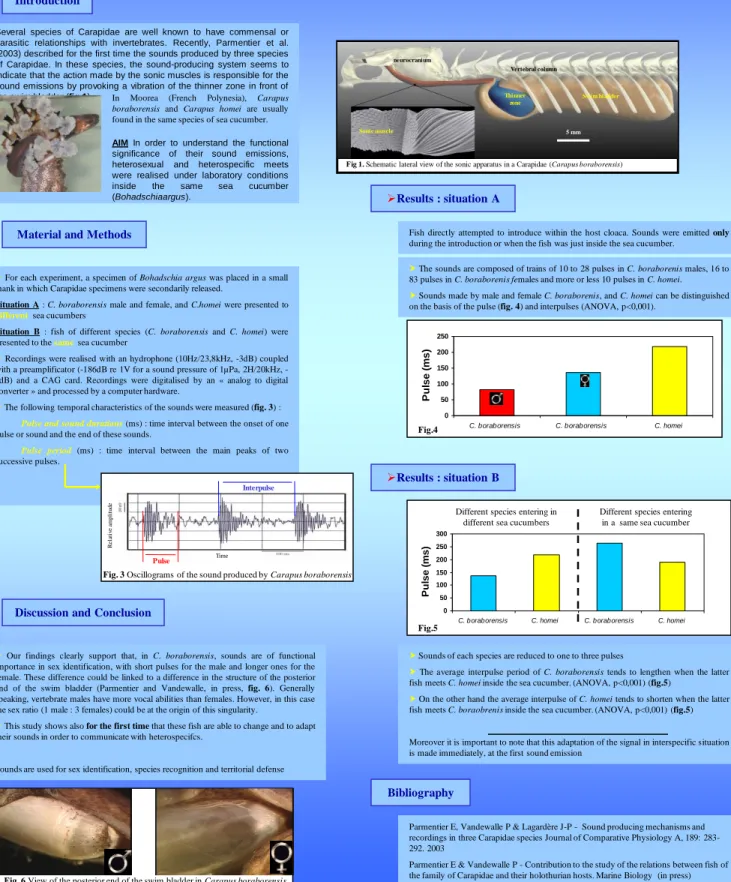Aspects of sound communication in the
pearl fish (Carapidae) under laboratory
conditions.
For each experiment, a specimen of Bohadschia argus was placed in a small thank in which Carapidae specimens were secondarily released.
Situation A : C. boraborensis male and female, and C.homei were presented to
different sea cucumbers
Situation B : fish of different species (C. boraborensis and C. homei) were presented to the same sea cucumber
Recordings were realised with an hydrophone (10Hz/23,8kHz, -3dB) coupled with a preamplificator (186dB re 1V for a sound pressure of 1µPa, 2H/20kHz, -3dB) and a CAG card. Recordings were digitalised by an « analog to digital converter » and processed by a computer hardware.
The following temporal characteristics of the sounds were measured (fig. 3) : Pulse and sound durations (ms) : time interval between the onset of one pulse or sound and the end of these sounds.
Pulse period (ms) : time interval between the main peaks of two successive pulses.
S. Millot
1, J.P. Lagardère
1,P. Vandewalle
2and E. Parmentier
21
CNRS, IFREMER, CREMA L’Houmeau, France
2
Lab. Functional and Evolutive Morphology, ULg, Belgium
Introduction
Material and Methods
Results : situation A
Fish directly attempted to introduce within the host cloaca. Sounds were emitted only during the introduction or when the fish was just inside the sea cucumber.
Discussion and Conclusion
Laboratoire de Morphologie Fonctionnelle et Evolutive 0 50 100 150 200 250 300C. boraborensis C. homei C. boraborensis C. homei
P u ls e ( m s )
Fig 1. Schematic lateral view of the sonic apparatus in a Carapidae (Carapus boraborensis) Sonic muscle Swim bladder Vertebral column neurocranium 5 mm Thinner zone Several species of Carapidae are well known to have commensal or
parasitic relationships with invertebrates. Recently, Parmentier et al. (2003) described for the first time the sounds produced by three species of Carapidae. In these species, the sound-producing system seems to indicate that the action made by the sonic muscles is responsible for the sound emissions by provoking a vibration of the thinner zone in front of the swim bladder (fig.1). In Moorea (French Polynesia), Carapus boraborensis and Carapus homei are usually found in the same species of sea cucumber. AIM In order to understand the functional significance of their sound emissions, heterosexual and heterospecific meets were realised under laboratory conditions inside the same sea cucumber (Bohadschiaargus).
The sounds are composed of trains of 10 to 28 pulses in C. boraborenis males, 16 to 83 pulses in C. boraborenis females and more or less 10 pulses in C. homei. Sounds made by male and female C. boraborenis, and C. homei can be distinguished on the basis of the pulse (fig. 4) and interpulses (ANOVA, p<0,001).
Results : situation B
Sounds of each species are reduced to one to three pulses
The average interpulse period of C. boraborensis tends to lengthen when the latter fish meets C. homei inside the sea cucumber. (ANOVA, p<0,001) (fig.5)
On the other hand the average interpulse of C. homei tends to shorten when the latter fish meets C. boraobrenis inside the sea cucumber. (ANOVA, p<0,001) (fig.5)
Moreover it is important to note that this adaptation of the signal in interspecific situation is made immediately, at the first sound emission
Different species entering in different sea cucumbers
Different species entering in a same sea cucumber
Bibliography
Parmentier E, Vandewalle P & Lagardère J-P - Sound producing mechanisms and recordings in three Carapidae species Journal of Comparative Physiology A, 189: 283-292. 2003
Parmentier E & Vandewalle P - Contribution to the study of the relations between fish of the family of Carapidae and their holothurian hosts. Marine Biology (in press) Our findings clearly support that, in C. boraborensis, sounds are of functional
importance in sex identification, with short pulses for the male and longer ones for the female. These difference could be linked to a difference in the structure of the posterior end of the swim bladder (Parmentier and Vandewalle, in press, fig. 6). Generally speaking, vertebrate males have more vocal abilities than females. However, in this case the sex ratio (1 male : 3 females) could be at the origin of this singularity.
This study shows also for the first time that these fish are able to change and to adapt their sounds in order to communicate with heterospecifcs.
Sounds are used for sex identification, species recognition and territorial defense
Fig. 6 View of the posterior end of the swim bladder in Carapus boraborensis Interpulse R e la ti ve a m p li tu d e Time Pulse
Fig. 3 Oscillograms of the sound produced by Carapus boraborensis
Fig.5 0 50 100 150 200 250
C. boraborensis C. boraborensis C. homei
P u ls e ( m s ) Fig.4
